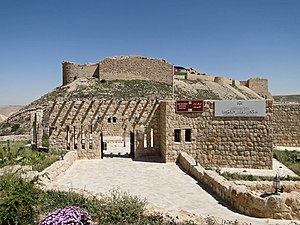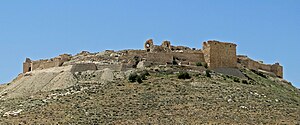Montreal (castle)
| Montreal Castle | |
|---|---|
قلعة مونتريال | |
| Shoubak, Jordan | |
 Montreal Castle and the Shoubak visitor Center | |
 Montreal Crusader Castle | |
| Coordinates | 30°31′53″N 35°33′36″E / 30.5313°N 35.5600°E |
| Site information | |
| Open to the public | Yes |
| Site history | |
| Built | 1115 |
| Built by | Baldwin I of Jerusalem |
Montreal (
Name
The Crusaders, who wrote their chronicles in Medieval Latin, Old French and Occitan,[1] mentioned the castle as Castrum Saboach or Scobach, or as Mons Regalis, Mont Real, and Monreal.[2] The second set of variants translate to 'Royal Castle' or 'King's Castle'.
The Arabic name is spelled variously as Shobak, Shawbak, Shaubak, Shubek, etc. The word castle or fortress translates in Arabic to qal'a.
Excavation history
As of 1994, the castle had never yet been fully excavated,[3] but as of 2006 it was being investigated by an Italian archaeological team from the University of Florence.[4]
History

The castle was built in 1115 by Baldwin I of Jerusalem during his expedition to the area when he captured Aqaba on the Red Sea in 1116. Originally called 'Krak de Montreal' or 'Mons Regalis', it was named in honor of the king's own contribution to its construction (Mont Royal). The castle is located on a round hilltop site that is separated from the rest of the plateau of Edom, which along with the Moab formed the core of Oultrejourdain. Despite appearance, the Edom plain was a relatively fertile location, which made the site, along with its strategic importance, highly desirable. The castle was strategically important due to the fact that it also dominated the main passage from Egypt to Syria. This allowed whoever held the castle to tax not only traders, but also those who were on pilgrimages to Mecca and Medina.[5] One of the major disadvantages of the site was the lack of a reliable source of water, an issue that the Crusaders encountered all over the Middle East. This problem was solved by the construction of a tunnel down the hill to two spring-fed cisterns. The tunnel allowed defenders to go and retrieve water without exposing themselves to any attackers.[3]
It remained property of the royal family of the
Structure
Little remains of the original Crusader fortifications. Although it has never been fully excavated, it is known that there was a set of three walls, which partially remain. The most significant remains of the Crusader portions of the Crusader castle is the remains of a curtain wall that ran inside the later Muslim additions and two chapels.[3] The towers and walls are decorated with carved inscriptions dating from 14th century Mameluke renovations, but the inside is in ruins. The pilgrim Thietmar, who saw the castle in 1217 after the Muslim conquest, referred to it as "a most excellent fortress, surrounded by triple walls and as strong as any I have ever seen".[3] The external walls and towers are attributed to the patronage of the Mamluk sultan Lajin.[5]
See also
- Wu'ayra Castle (li Vaux Moysi), an outpost of Montreal near Petra
References
- "The Crusades" by Hans Mayer
- "The Age of the Crusades: The Near East from the Eleventh Century to 1517" by Peter Holt
Notes
- )
- )
- ^ OCLC 28928501.
- ^ http://www.shawbak.net Archived 2006-12-08 at the Wayback Machine (in Italian)
- ^ JSTOR 25188591.
- ISBN 978-0-674-28397-8


